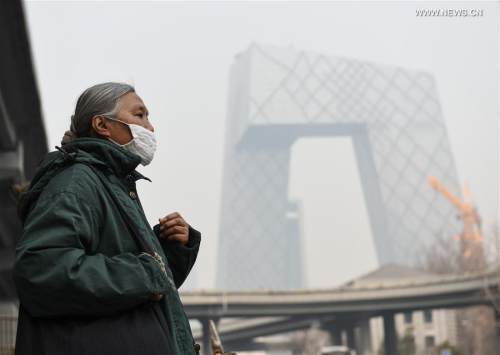
A woman wearing a mask walks past Guomao Bridge in Beijing, capital of China, March 16, 2016.(Photo: Xinhua/Luo Xiaoguang)
Levels of PM2.5 in the Beijing-Tianjin-Hebei area had been reduced by 14.3 percent year-on-year
The Ministry of Environmental Protection has sent 10 teams to inspect the performance of 20 provinces in controlling air pollution amid calls to reduce smog in winter after northern regions experienced poor air quality recently.
The inspection teams will focus on the implementation of major efforts such as shutting down illegal construction projects and polluting companies, and reviewing regular inspections of local environmental teams, the ministry said.
The 20 provinces to be inspected includes the northern and northeastern provinces of Tianjin, Hebei, Shanxi, Henan and Liaoning, as well as southern provinces such as Fujian and Guangdong.
The ministry highlighted the need to address heavy smog expected in the coming winter, especially in the Beijing-Tianjin-Hebei area.
When Beijing's central heating system is switched on in mid-November, a substantial rise in carbon emissions, as well as static weather patterns, would make it difficult for airborne pollutants to disperse, causing smog and poor air quality.
However, vast areas in the country's northern regions have already been hit by severe smog, several weeks before the central heating system has been switched on.
Smog affected 70 cities in the Beijing-Tianjin-Hebei area and neighboring provinces on Oct 17 and 18, and expanded to cover an area of 260,000 square kilometers on Oct 19, the ministry said.
Chen Jining, minister of environmental protection, urged local governments to make greater efforts in dealing with air pollution.
Complicated issues such as industrial structures; energy consumption, particularly relating to coal; and heavy traffic have made controlling air pollution a tough task in the region, but it must be a priority in the coming months, Chen said.
The ministry has highlighted the need to reduce smog in winter if the country is to meet central government goals by 2017.
He Kebin, head of the School of Environment at Tsinghua University, said a national campaign to reduce smog has helped improve air quality, adding that until Oct 19, levels of PM2.5-fine particulate matter less than 2.5 micrometers in diameter that is hazardous to human health-had been lowered by 14.3 percent year-on-year in the Beijing-Tianjin-Hebei area.
"The improvement was not large enough to present visible changes, but continued efforts in the region could help to prevent the air quality from worsening in winter," He said.


















































